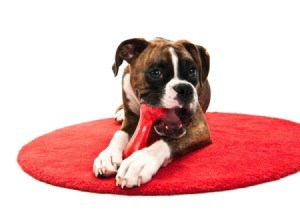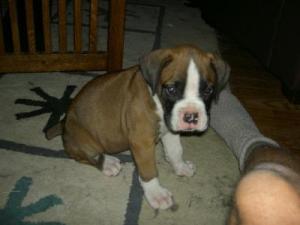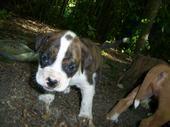 I have a 7 month old boxer puppy that will not quit attacking everyone's feet and at the same time he barks and jumps up at you. It hurts very badly when he bites at your feet or legs and when he jumps on you he scratches you all up. I already tried hiring a trainer and it didn't work.
I have a 7 month old boxer puppy that will not quit attacking everyone's feet and at the same time he barks and jumps up at you. It hurts very badly when he bites at your feet or legs and when he jumps on you he scratches you all up. I already tried hiring a trainer and it didn't work.
Savannah - congrats on owning one of the best breeds of dogs for families - loyal, kid-friendly, looks ferocious but might lick you to death! They are tough during the puppy stage, but give this a try. Buy several of those breath-freshing spray bottles - you know, the little ones at the check-out counter. Pass them around to family members or friends, anyone who might be subjected to your puppy's bad habit. When he attempts to nip or bite or jump up on you, give him a good squirt in the face - not the eyes!!!
Do NOT use a human based spray on a dog! Use plain water if needed. But that really is normal puppy stuff. You can act wounded & shout ouch & walk away. Or keep him on a leash when you have company or anyone. The person needs to be just out of the leashes length when they greet & pet him. Reward him when he allows the person to pet him.
I agree with "Me". This is normal puppy behavior. They get excited by your feet moving, and are really just playing, but boy those teeth sure are sharp! He will grow out of it, but like "Me" says, say "Ouch" really loud, act hurt and walk away. Pups are smart and will understand they have done something wrong. Another thing is using a spray bottle of water, and give him a squirt when he bites. Please don't use breathe spray. If it got in his eyes, it could really hurt and possibly damage his eyes.
As a dog trainer, I get this question a lot. Sorry, I'm probably going to get a bit wordy here, but I want to help you prevent a what will become a big problem if you let this behaviour escalate.
Your puppy has continued with this behaviour because he gets rewarded for it in some way (i.e. attention, touch). You don't need to resort to sprays because these are unnecessary and problematic. Taking his paws and telling him "no jumping" will probably be counterproductive (he may be interpreting this as play, or at the least, attention). He needs to learn that he'll get what he wants (attention) when he gives the behaviour you want (four feet on the ground). You can do this simply by removing all attention when he's jumping up -- this means no eye contact, no touch, no voice, and perhaps even removing your presence. NOTE: Timing is everything at the beginning learning stages of this new way to greet people. The instant his four feet are on the ground, say a happy "yes!" or "good boy!" and pet him and keep giving him lots of attention as long as he has his four feet on the ground. However, the instant he jumps up again -- which he will do because he hasn't learned about self-control yet -- remove touch, voice, eye contact, etc. Continue and he'll figure it out surprisingly quick. Tip: if he jumps up and "hangs on" just turn your body and move a bit until his four paws are on the ground. Then, instantly praise for the four feet on the ground. Explain/teach the new rules to all humans who will meet your dog.
You can progress to getting the dog to sit when guests arrive. Start with your dog on a leash if you can, with a helper if possible to open the door to let the guests in. Put the dog in a sit/stay (and have him hold the stay of his own accord, not with you holding him back with a tight leash) and have the helper (or yourself) move to the door to let in the guest. The instant your dog breaks the stay, stop all progress of letting in the guest. Have the dog sit/stay again and start from the beginning. For example, say your dog holds the stay as the helper walks towards the door and turns the door knob but breaks the stay when the door is beginning to open. Give the signal "no" not too sharp, just serious but calm and at the same time, a split second after the no. The helper (or you) should stop and go back to the first stage of letting in the guest. After the dog is in the sit/stay (remember: loose leash) begin again at stage one and proceed as before, being careful to give the "no" signal when the dog breaks the stay and making sure to begin again at the beginning stage each time. Your dog will begin to figure out that he gets what he wants (to see who is at the door and potentially greet the guest and get pets) when he holds the stay. If you don't have the time to practice this, then remove your dog from the room when you let the guest in. You don't want to reward the dog by letting the guest in if your dog is not giving you appropriate behaviour.
NOTE: a dog that greets guests by rushing to the door, pushing his nose past the humans opening the door, and jumping on people is showing signs of dominance. If left unchecked, this can escalate. I suggest some in house training on the leash where your dog enters/exits doorways only after a sit and a command and, when possible, after the human. Communicate to your dog that humans are higher in the pack, by requiring your dog to "say please " (the sit) for things and by having him follow the leaders and not lead the way will help a lot in all aspects of your dog's relationship in the pack. Seriously. And NEVER let your dog pull on the leash when you walk. If he pulls, stop, call him to you happily and begin to walk in the opposite direction (not a sharp stop; give him a chance to stop on his own accord) and have him walk towards you (do not pull him towards you). Move in the opposite direction, and this will cause the leash to tighten, but keep the length the same and continue to walk in the opposite direction until he walks towards you fast enough to cause the leash to slacken. When the leash has become slack, say "yes" or "good boy" and change direction back to the original forward direction. Continue back and forth -- not letting him get any closer to the park or the tree or down the sidewalk unless he is on a loose leash. This requires your dog to manage and control his own behaviour to get what he wants and will save your body and nerves from strain. NOTE: with this method, walk by time, not distance. Decide on a time (i.e. a 20 minute walk) and walk in one direction for 10 minutes then head for home. Your dog will quickly figure it out that he gets closer to the park or gets to see and sniff more things if he controls himself. At the beginning stages you'll do a lot of back and forth stuff and you probably won't get very far, but your dog has still been walking, so he's getting the exercise. Trust me, this method works but only if you are consistent. Be determined that you will no longer be pulled by your dog that is "telling you that you are to follow him." Don't let your dog order you around, because that's what he's thinking when he's walking on a tight leash. He doesn't think you are pulling him back; he thinks he is pulling you along and he's winning or you are wanting him to pull you if you let him. He's thinking that you are acknowledging him as the leader, and so he'll feel free to take on all the leadership roles and perks, and that's when your problems escalate into jumping on guests, being pushy with people by demanding the best places to sit and sleep, demanding bits of your food, demanding treats, growling at guests at the door, and correcting (i.e. biting) humans he feels have overstepped their position in the pack.
I hope this helps.
I have a new puppy that does the same thing - plus bites the hands and jumps and tries to bite my neck, face or whatever. I know she is playing, but I don't want to lose an eye either. I asked a few people and have heard a few different actions. My favorite that I think I will try is Lemon Juice. Apply to the hands and ankles, when they bite they won't like it at all and will probably stop very quickly.
I am starting it immediately. She also likes to dive into thecats litter box (it has a covered top) and eat their poop. She gets the highest quality food, a mic of wet and dry, so it isn't hunger. She has eaten it jsut after eating food from the bowl and leaving some behind.
Best of luck to us all....

My dog does really good with the NO BITE thing and he also does good with the walking away part.

Here are the questions asked by community members. Read on to see the answers provided by the ThriftyFun community.
I have an 11 month old boxer. She is a female. She has been through classes and knows the basic commands (sit, stay and come). She also shakes and uses a bell at the back door when she needs to go potty.
But she jumps on people, barks while in the car and will not sit in the back seat, and she pulls on the leash. Can anyone give me ideas to help her stop these behaviors?
By Sherri
One thing I have learned about the pulling on a leash is to use a head collar. It doesn't harm them in any way, but they just don't like the fact of being lead by their muzzle. It helps my lab and hound mix who pulls me everywhere. When I walk he walks, when I stop he sits besides me. It's the greatest.
Boxers are intelligent dogs, I'm sure you know that. For jumping on people, have them ignore her (don't make eye contact with her either). If she jumps on them, they should turn their back to her. She should not be addressed (petted, talked to) until she sits. She's doing it for attention; if she doesn't get the attention, she'll stop doing it. Important - have everyone entering ignore her for 5 minutes or so, until she is sitting.
For barking in the car, try taking a bone or favorite toy to keep her attention. Also, praise her when she is quiet - try to ignore her when she is barking. But the praise when doing the right thing is *key*.
As far as keeping her in the backseat, the bone or toy might help with that. You could also get a safety belt (which she should be wearing anyway in case of an accident). The safety belt will keep her in the backseat.
It's more productive to praise for good behavior than to punish for bad behavior.
For pulling on the leash - if she pulls, you stop. Start walking....if she pulls again, stop. Keep doing this until she learns that when she pulls, you don't move. Remember to praise her when she is walking with you, not dragging you.
You might also try taking another class, because walking on lead is a basic instruction.
Boxers are high-energy dogs and a tired dog is a good dog! So give her the exercise she needs, play with her for 20 minutes or so to expend some of that energy - and when she's pooped, take her for a walk - she should be alot more calm and willing to just take a walk with you.
I love watching Cesar Millan, the Dog Whisper, and implementing what he does. His site as info on these. Here is the link for the Jumping on people. Browse his site for the Barking and Pulling issues. Hope this helps! One thing I have learned, no matter what, you have to be consistent.
www.cesarsway.com/
ThriftyFun is one of the longest running frugal living communities on the Internet. These are archives of older discussions.